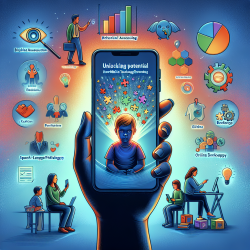Introduction
In the ever-evolving field of speech-language pathology, the integration of technology into practice has opened new avenues for improving outcomes for children. One such advancement is the use of mobile technology to assess autism risk in young children, as highlighted in the study "Automatic emotion and attention analysis of young children at home: a ResearchKit autism feasibility study." This blog explores how practitioners can leverage these findings to enhance their practice and encourages further research in this promising area.
The Study in Focus
The study utilized an iPhone-based app, Autism & Beyond, to collect data from 1,756 families with children aged 12–72 months. Over a year, caregivers uploaded 4,441 videos of their children watching stimuli designed to elicit autism-related behaviors. The app automatically coded these videos to quantify emotions and attention, revealing significant differences based on age, sex, and autism risk status. This approach demonstrated the feasibility of using mobile technology for autism screening outside of clinical settings.
Implications for Practitioners
For speech-language pathologists, this study offers several key takeaways:
- Scalability and Accessibility: Mobile technology provides a scalable solution for assessing autism risk, making it accessible to families who may not have easy access to clinical services.
- Data-Driven Insights: The automatic coding of emotions and attention provides objective data that can enhance the accuracy of assessments and inform intervention strategies.
- Engagement with Caregivers: By involving caregivers in data collection, practitioners can gain a more comprehensive understanding of a child's behavior in natural settings.
Encouraging Further Research
While the study demonstrates the potential of mobile technology in autism screening, further research is needed to validate these tools across diverse populations and settings. Practitioners are encouraged to explore the following areas:
- Cross-Cultural Validation: Investigate how these tools perform in different cultural contexts to ensure their applicability and accuracy globally.
- Longitudinal Studies: Conduct long-term studies to track developmental changes and the impact of early interventions informed by mobile assessments.
- Integration with Other Technologies: Explore the integration of mobile assessments with other digital tools, such as teletherapy platforms, to create comprehensive intervention plans.
Conclusion
The integration of mobile technology into autism screening represents a significant advancement in the field of speech-language pathology. By embracing these tools, practitioners can enhance their assessments, engage more effectively with caregivers, and ultimately improve outcomes for children. As we continue to explore and refine these technologies, the potential for transforming autism screening and intervention is immense.
To read the original research paper, please follow this link: Automatic emotion and attention analysis of young children at home: a ResearchKit autism feasibility study.










